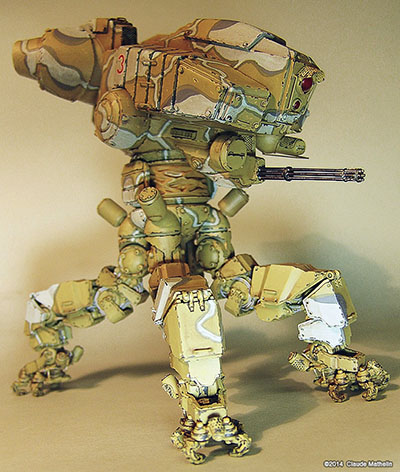
^ Claude Mathelin's Rook, from a kit of an original design produced by Industria Mechanika. |
An obvious component to the stable of sci-fi vehicles are "mecha". First coined by the Japanese, the strict definition of "mecha" covers anything mechanical, from vehicles to computers; "robot" (robotto to the Japanese) refers to a vehicle that has limbs or a "biological" appearance. For our editorial purposes we'll define "mecha" as manned power suits and giant robots that have limbs/appendages used for mobility and activity. They may be piloted or controlled remotely by humans, or under control of an on-board artificial intelligence. The earliest mecha may have been a steam-powered, human-piloted mechanical elephant found in Jules Verne's novel "The Steam House", published in 1880. H.G. Wells Martian Tripods (War of the Worlds) and Robert Heinlien's Mobile Infantry battle suits (Starship Troopers) are later examples. While most mecha are depicted as combat machines, there are notable examples of civilian use such as the "labors" in the Patlabor series. Imported from Japan, mecha became popular in the States during the 80's, through translated (and often extensively re-written) TV shows such as Voltron and Robotech. Since then, the concept has been accepted into many western sci-fi creations. The number of mecha-related shows (and their associated models) is dizzying... and we're happy to cover any and all of them! For more mechs of all kinds, check out our Readers' Gallery.
Battletech |
Gundam |
MA.K. ZbV 3000/ SF3D |
Macross |
Battletech (Mechwarrior) |
|
In Battletech, humanity is in a technological decline after thousands of years of expansion into space. The Great Houses of the Inner Sphere battle each other as well as the invading "Clans" - Humans, descended from one of the Star League's greatest leaders and the army that he took with him during the Exodus. The pinnacle of human military achievment are Battlemechs: large, heavily armed walkers with a huge array of weaponry. Beginning in 1984 as a simple board game using robot designs lifted from Japanese anime, FASA built Battletech into a massive franchise covering everything from books and models to computer games. (It's been owned since 2003 by Topps). The Mechwarrior video games breathed new life into the franchise in the 1990s, and both the tabletop and video games are still going strong today. While gaming miniatures in varying sizes are readily available, there have not been many model kits produced (and no plastic kits outside of the original Japanese subjects from which many Battletech designs were copied). References
|
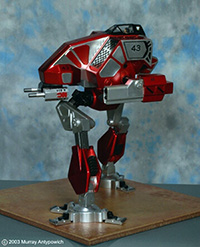
^ Murray Antypowich's scratchbuilt Vulture Battlemech (in the Reader's Gallery) |
|
Articles & Reviews
|
|
Gundam |
|
Of all Japanese mecha, those from the Gundam series of movies and TV shows are far and above the most enduring and extensive. Starting in the first Gundam series in 1979, Mobile Suit Gundam, Japanese audiences and eventually the world were introduced to one of the most intricate and longest stories in sci-fi today. The Earth-based Federation and it's conflicts with the space based Zeons became what is now known as the Universal Century timeline. Several different series in this UC timeline take us through the wars, with each series having its own viewpoints on the conflicts and expanding upon themes explored in previous series, all the while continuing along a common timeline. There is another Gundam "universe" called the Alternate Timeline or "AC timeline". In this timeline all the rules from the UC timeline have been thrown out as if those shows never existed and Gundams are used in all sorts of fantastical storylines. Each series in this timeline is really a world unto itself, as none of them relate to each other or even follow a common calendar. One series shows them as giant suits used as gladiators while another shows them as superhero, Earth's last hope types. Gundam models are widely available as kits in every material and scale. References
|
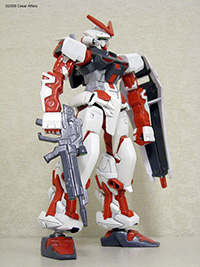
^ Cesar Alfaro's Gundam Astray Red Frame (in the Reader's Gallery) |
|
Articles & Reviews
|
|
Maschinen Krieger Zbv. 300 (Ma.K)/ SF3D |
|
Maschinen Krieger ZbV 3000 (originally SF3D) was the brainchild of Japanese artist/modelmaker Kow Yokoyama. Dissatisfied with the mechas and giant robots popular in the early eighties, he dreamed up a world filled with gritty, functional and retro-looking robots and vehicles. The SF3D stories, serialized in Hobby Japan, were set in the late 29th century on an Earth slowly recovering from the environmental devastation of the third world war, only to be plunged into chaos again as settlers returning from various space colonies (mostly of Commonwealth origin) fall into dispute with their government, the Shutoral Demokratische Republik. This results in areplay of World War 2. Yokoyama-san's designs were produced as plastic kits by NITTO Japan and were the first major multi-media science fiction kits released. In 1986, a copyright dispute with Hobby Japan brought the original incarnation of the series (and kit production) to an end. After years of leegal wrangling, Mr. Yokoyama was awarded the full copyright to the series in the 1990s. He and Hobby Japan eventually reconciled and restarted their working relationshipunder the new name Maschinen Krieger ZbV3000 (otherwise known as Ma.K). Since then, the series has undergone a marked revival. Old kits have been reissued by Wave, and both Wave and Hasegawa have issued new tool injection plastic kits whose detail and ease of assembly matches anything available in more m"mainstream" scale modeling segments. Addionally, a wide assortment of resin kits of vehicles and figures can be found. The most popular scale for MaK subjects is 1/20, but models and accessories are easily obtained in other popular scales (1/35, 1/72, etc.) as well. References
|
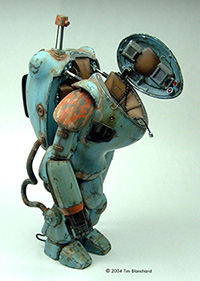
^ Tim Blanchard's Raptor (in the Reader's Gallery) |
|
Articles & Reviews
|
|
Macross |
|
Next to the Gundam property, Macross is one of Japan's longest running series (TV, movies, and OAVs). It's one of the three animes that was used to create the U.S. Robotech series in the '80s. The popularity of the Macross saga led to a number of sequels and spin-offs, including the movies Macross: Do You Remember Love, Macross Flashback 2012, Macross II, Macross 7 and the Macross Plus OAV/movie series. Many of the newer series, such as Frontier and Delta, contain innovative new mecha designs, as well as new twists on older favorites like the original VF-1 Valkyrie fighters. Macross model kits from the most popular series are readily available in many different scales and materials, from a host of manufacturers. And if you can't find what you're looking for in plastic, there is almost certainly a resin kit out there (though you may have to troll eBay for a while to find it!) References
|
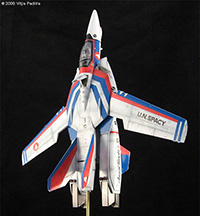
^ Vitja Padilla's VF-1 Valkyrie (in the Reader's Gallery) |
|
Articles & Reviews
|
|
Other Anime |
|
The Japanese, more than anyone else, have a long-running fascination with mecha; the long list of anime, manga and even live-action shows over the years proves it. Notable examples include: Patlabor: Mobile Police Force. A mostly light-hearted, near-future (late 1990's, though the show was created in the late eighties) drama revolving around a special division (SV-2, for "Special Vehicles Section Number Two") of the Toyko police. In Patlabor's 1990's, we have developed large utility robots to help us in areas like heavy construction. The series' premise has it that with the introduction of these giant work machines, called "Labors", came the abuse of their technology for criminal purposes. Thus "Patlabors" (a contraction of "Patrol Labors") were developed to deal with these abuses. The show was one of the first to transition successfully from OVA to TV (an eventual 47 episodes were made) and thence to the big screen. Neon Genesis: Evangelion. To the casual eye, this series may seem like fairly typical Japanese giant robot fare. However, watch a few episodes with your braincells engaged and you'll find it to be a complex tale, rich in mystery and metaphor. The 26-episode story is a worthy peer of epics like Babylon-5 or The Prisoner, in the way it plays with imagery, religious iconography, archetypes, and epic storytelling. The mechs are pretty darn impressive as well - a departure from the heroic humanoid Gundam/Patlabor/VOTOMS style so prevalent in Japanese anime. Robotech is the series which introduced America to Japanese animé in 1985. Three series with independent stories- Macross, Southern Cross, and Mospeada - were combined to form one story line chronicling the events of three generations defending the Earth with their transformable mecha. Certain plot elements and original names were changed from the originals; ie “Genesis Climber Mospeada” became Robotech: New Generation, and the “Legioss” mecha became "Alpha". The early eighties anime Armored Troopers VOTOMS featured squat, utilitarian designsthat were a departure from the ornate, anthroporphically heroic designs of Mobile Suit Gundam. It may be this aspect that has given these designs a lasting influence, serving as springboard for other mechs, including those of the Heavy Gear® universe. References
|
^ Guy Garrisson's Fuchikoma (from Ghost in the Shell) in the Reader's Gallery
^ Matthew Panas' Ingram (from Patlabor) in the Reader's Gallery |
|
Articles & Reviews
|
|
Other Sources & Original Designs |
|
Mecha and giant, piloted robots are not found solely on Japanese TV. Games - from video games like Armored Core and Metal Gear to tabletop games like Heavy Gear and jovian Chronicles - feature some wildly inventive designs. And of course, you don't need someone else's imagination to come up with these if you have your own! References
|
^ Marcel Bastien's Syreen (Jovian Chronicles) |
|
Articles & Reviews
|
|
Links & Resources |
|
Modeling:
General:
|

Go back up | Starship Modeler Home | Site Map | Feedback
This page made possible by Starship Modeler™ - copyright © 1998-2010.
Last updated on 27 July 2016.